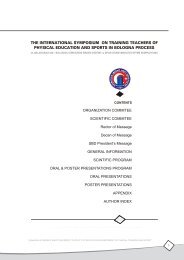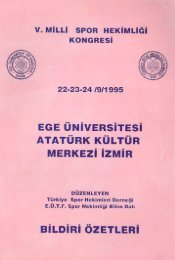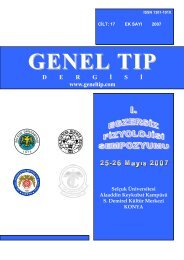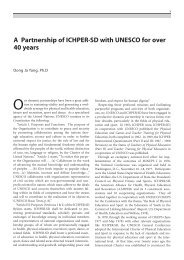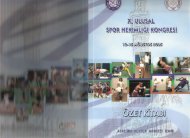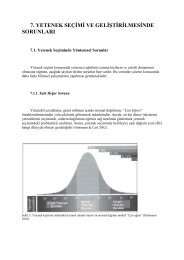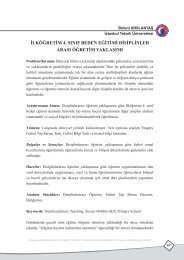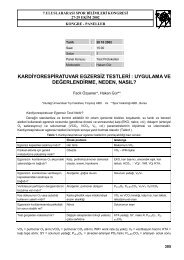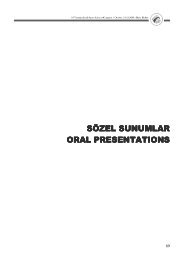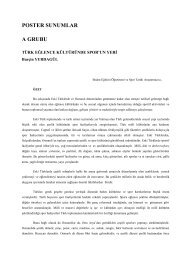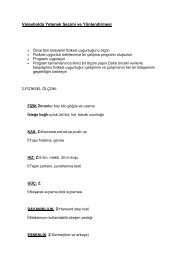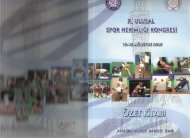- Page 1 and 2:
TÜRKİYE PROFESYONEL LİGLERİNDE
- Page 3 and 4:
3-BULGULAR Milattan 2500 yıl önce
- Page 5 and 6:
Kursu” açılmasına yol açmış
- Page 7 and 8:
Tablo 3 : Türkiye Profesyonel Ligl
- Page 9 and 10:
100 90 80 70 60 50 40 30 20 10 0 9
- Page 11 and 12:
Tablo 8 : Türkiye Profesyonel Ligl
- Page 13 and 14:
Tablo 10 : Türkiye Profesyonel Lig
- Page 15 and 16:
aktığımızda iller arasında sta
- Page 17 and 18:
activities doing individual partici
- Page 19 and 20:
MATERYAL VE YÖNTEM Araştırmada t
- Page 21 and 22:
N % N % N % 1 Futbol 36 2.9 34 5.3
- Page 23 and 24:
Tablo 6. Türkiye’deki Üniversit
- Page 25 and 26:
öğrencilerin yüzdesi % 61.9, kı
- Page 27 and 28:
oynamayı, %24.2’sinin müzik din
- Page 29 and 30:
DEĞİŞEN DÜNYADA SPOR ENDÜSTRİ
- Page 31 and 32:
içinde bulunduğu tüm sosyal ve e
- Page 33 and 34:
Tablo 2. Ülkelere Göre Spor ve Me
- Page 35 and 36:
geliştirilecek politikalara ihtiya
- Page 37 and 38:
G.S.G.M’ YE BAĞLI AMATÖR SPOR F
- Page 39 and 40:
Etkili yöneticilik; çok yönlül
- Page 41 and 42:
CINSİYET f 22 25 47 % 46.8 53.1 10
- Page 43 and 44:
20 25 Personel 47 5 10.6 6 12.8 20
- Page 45 and 46:
Çatışma yönetim stillerinden
- Page 47 and 48:
Bir örgütte çatışma çıkması
- Page 50 and 51:
ÖZET SPOR SPONSORLUĞUNUN BAŞARIS
- Page 52 and 53:
Kuruluşlar, topluma yönelik faali
- Page 54 and 55:
1. Adım Amaçların Belirlenmesi E
- Page 56 and 57:
3. Posta Yoluyla Yapılan Anketler:
- Page 58 and 59:
testlere ihtiyaç duyulur. 2. Spons
- Page 60 and 61:
görülmektedir (Pope, 1998). Spons
- Page 62 and 63:
SPINDEX ölçümleri İngiltere, AB
- Page 64 and 65:
konusudur. İngiltere’de 20.000 k
- Page 66 and 67:
ile ürün / marka veya firmanın b
- Page 68 and 69:
alındığı ifade edilmektedir. An
- Page 70 and 71:
aşacak gelir elde etmeyi hedefledi
- Page 72 and 73:
söylemek mümkündür. Her bir ama
- Page 74 and 75:
Özet The Potential Contributions o
- Page 76 and 77:
kurmaları için fırsatlar sunabil
- Page 78 and 79:
· Olimpik Hareketin bağımsız fi
- Page 80 and 81:
Olimpiyat Oyunlarının 1936 yılı
- Page 82 and 83:
Kaynaklar Crimmins J.,&Horn M. (199
- Page 84 and 85:
maç oynadığı düşünülürse F
- Page 86 and 87:
Türkiye’de ise bu konu çok öne
- Page 88 and 89:
BULGULAR Tablo 3’de verilen bulgu
- Page 90 and 91:
değeri .91 olarak saptanmıştır.
- Page 92 and 93:
KAYNAKLAR (1) Karaküçük, S. ve Y
- Page 94 and 95:
Futbol maçına gittiğim zaman di
- Page 96 and 97:
Tablo 4: Ölçeğin orjinal değerl
- Page 98 and 99:
sağlanabilmektedir. Televizyonun y
- Page 100 and 101:
KAYNAKÇA (1) Authier,C., Futbol A.
- Page 102 and 103:
Materyal ve Yöntem Araştırmada k
- Page 104 and 105:
A.B.D MAÇI (2-3) 10.Kasım.03 Paza
- Page 106 and 107:
Sütun SABAH GAZETESİ Toplam Alan
- Page 108 and 109:
görmüştür. Türkiye’nin oynad
- Page 110 and 111:
İtalya Uygulaması : Gazzetta dell
- Page 112 and 113:
Tablo No: 7 Türk ve İtalyan Bayan
- Page 114 and 115:
Sport section of Turkish newspapers
- Page 116 and 117:
organizasyon dışındaki işletmel
- Page 118 and 119:
Tablo 3.: Çalışmaya katılan spo
- Page 120 and 121:
Tablo 9.: Çalışmaya katılan spo
- Page 122 and 123:
Tablo 15.: Çalışmaya katılan sp
- Page 124 and 125:
Tablo 21.: Çalışmaya katılan sp
- Page 126 and 127:
5- SONUÇ Spor kulüplerinde başar
- Page 128 and 129:
Bu çalışmada, antrenör davranı
- Page 130 and 131:
Tablo 3’deki araştırma sonuçla
- Page 132 and 133:
Tablo 10. A-Lisans Antrenörlerin S
- Page 134 and 135:
Edilgen davranışların pek çoğu
- Page 136 and 137:
KAYNAKLAR 1. ACET, M., “Futbol Se
- Page 138 and 139:
2 GİRİŞ Spor bir toplumda fertle
- Page 140 and 141:
4 Tablo 4: Milletvekillerinin Spor
- Page 142 and 143:
6 Yukarıdaki tablodan da izlenece
- Page 144 and 145:
8 mezunlarının, %48.3’ünün
- Page 146 and 147:
10 Milletvekillerinin, vekil olmada
- Page 148 and 149:
934 ELAZIĞ İL MERKEZİNDEKİ SPOR
- Page 150 and 151:
(24). Sporun gelişmesi ve toplumda
- Page 152 and 153:
Kurum adı Gençlik spor il müd. O
- Page 154 and 155:
Tablo 7: Spor Tesislerinden Faydala
- Page 156 and 157:
Üniversitesi Spor Bilimleri ve Tek
- Page 158 and 159:
çatışmalarına çözüm getiren
- Page 160 and 161:
SPOR TAHKİM MAHKEMESİ Anlaşmazl
- Page 162 and 163:
dayandı. Konferansta ayrıca spor
- Page 164 and 165:
Tablo 2.Sporda Tahkim sistemine gir
- Page 166 and 167:
http://heinonline.org/HOL/Page?hand
- Page 168 and 169:
GİRİŞ VE AMAÇ “Kelime anlamı
- Page 170 and 171:
ÇALIŞMA ŞEKLİNİZ n % TABLO 6 -
- Page 172:
SONUÇ İzmit Büyük Şehir Beledi
- Page 175 and 176:
GİRİŞ VE AMAÇ Spor seviyesinin
- Page 177 and 178:
TABLO 3 : Sporun Tabana Yaygınlaş
- Page 179 and 180:
SONUÇ Gençlik ve Spor Genel Müd
- Page 181 and 182:
faaliyetlerini yürütebiliyorlard
- Page 183 and 184:
oldukça ileri bir durumda bulunuyo
- Page 185 and 186:
ASKERİ LİSE İLE SİVİL LİSELER
- Page 187 and 188:
Otur-eriş Testi: Esneklik ölçüm
- Page 189 and 190:
Aktif Sıçrama ortalamaları; ASLK
- Page 191 and 192:
7. Baranowski T., Smith, M., Thomps
- Page 193 and 194:
TÜRK ARTİSTİK CİMNASTİK MİLL
- Page 195 and 196:
Tablo 1 incelendiğinde; cimnastik
- Page 197 and 198:
KAYNAKLAR 1. Özer K. (1992). Artis
- Page 199 and 200:
GİRİŞ Egzersiz çocukların her
- Page 201 and 202:
Sporun çocuk gelişimi üzerine et
- Page 203 and 204:
Tablo 1: Basketbolcu ve sedanter ç
- Page 205 and 206:
Ref # : 289 Category : Health and S
- Page 207 and 208:
MATERYAL VE METOD Çalışmaya kat
- Page 209 and 210:
BULGULAR: Bayan ve Erkek Bale Dans
- Page 211 and 212:
Bayan ve Erkek Bale Dansçıların
- Page 213 and 214:
Çap ölçümlerinde bayan ve erkek
- Page 215 and 216:
ÖZET Bu araştırmanın amacı, As
- Page 217 and 218:
(hemoglobin) ve Hct (hemotokrit) pa
- Page 219 and 220:
TARTIŞMA VE SONUÇ ASLKÖ’ in ve
- Page 221 and 222:
934 RESEARCH ABOUT THE EFFECT OF IS
- Page 223 and 224:
(fleksiyon/ekstensiyon) peak tork d
- Page 225 and 226:
seçilmiştir. Gene, izokinetik kuv
- Page 227 and 228:
Sporcular test hakkında bilgilendi
- Page 229 and 230:
Tablo 4.2. Deneklerin sprint sürat
- Page 231 and 232:
Tablo 4.8. Deneklerin sprint koşu
- Page 233 and 234:
ile çabuk kuvvetin karşılaştır
- Page 235 and 236:
ÖZET ANTRENMAN DÖNEMİNDEKİ PROF
- Page 237 and 238:
ANTRENMAN DÖNEMİNDEKİ PROFESYONE
- Page 239 and 240:
Kortizol ve Büyüme hormonu düzey
- Page 241 and 242:
Kaynaklar: 1. Baj Z, Kantorski J. e
- Page 243 and 244:
4-Omurga: Dansçıların omurgası
- Page 245 and 246:
(Tablo 2). Tablo 2: Dansçıların
- Page 247 and 248:
Tablo 7: Dansçıların ayak parmak
- Page 249 and 250:
Tablo 12: Dansçıların başların
- Page 251 and 252:
Tablo 18: Dansçıların diz ardı
- Page 253 and 254:
Pes planus’un her iki cinsiyette
- Page 255 and 256:
6-Hamilton WG, Hamilton LH, Marshal
- Page 257 and 258:
zamanlama açısından önemlidir(5
- Page 259 and 260:
Yapılan testler sonucunda denekler
- Page 261 and 262:
4. Akşit T, Özgürbüz C, Acar M.
- Page 263 and 264:
ABSTRACT INVESTIGATION OF CORRELATI
- Page 265 and 266:
GİRİŞ Antrenman, bireyin bedense
- Page 267 and 268:
İstatiksel Analizler İstatistik a
- Page 269 and 270:
Solunum Fonksiyonları İle WT Para
- Page 271 and 272:
çalışmalarda gösterilmiştir (3
- Page 273 and 274:
8. Bouchard, C, Taylor, AW, Simonea
- Page 275 and 276:
GİRİŞ Teknolojinin gelişmesine
- Page 277 and 278:
Tablo 3: Eşleştirilmiş T Testi
- Page 279 and 280:
7. Chatterjee S. Mandal A., Das N.:
- Page 281 and 282:
GİRİŞ Artistik cimnastikte başl
- Page 283 and 284:
Botwinich ve Thompson yaptıkları
- Page 285 and 286:
1 Trauma Incidence of Elite Taekwon
- Page 287 and 288:
3 The questionnaire related to fore
- Page 289 and 290:
5 teeth. Following the dental traum
- Page 291 and 292:
REFERENCES 7 1. Birrer RB, Halbrook
- Page 293 and 294:
9 21. Ranalli DN: Sports dentistry
- Page 295 and 296:
Table 2. Questionnaire of the sport
- Page 297 and 298:
Table 4: Distribution of orofacial
- Page 299 and 300:
Table 6: Awareness of forensic aspe
- Page 301 and 302:
Sonuç:.Erkek ve kız çocuk sporcu
- Page 303 and 304:
BULGULAR Araştırmaya katılan den
- Page 305 and 306:
Araştırmaya katılan kız sporcu
- Page 307 and 308:
(Tablo 2), (Tablo 3). Her iki cinsi
- Page 309 and 310:
2. Balcı ŞS (2002) Genç Erkek T
- Page 311 and 312:
GİRİŞ FILA kuralarına uygun bi
- Page 313 and 314:
Tablo V: Salto Bağlama Sayısı ve
- Page 315 and 316:
Doğu Uluslar arası serbest güre
- Page 317 and 318:
Ref # : 648 Category : Movements an
- Page 319 and 320:
YÖNTEM Bu araştırmada yarı dene
- Page 321 and 322:
SONUÇ Tablolardaki rakamlardan 1,
- Page 323 and 324:
Tablo 4. Deneklerin normal ve düş
- Page 325 and 326:
Tablo 6. Deneklerin düşük ve yü
- Page 327 and 328:
yaptıkları çalışmada görsel r
- Page 329 and 330:
her ne kadar bu çalışmada anlaml
- Page 331 and 332:
KAYNAKLAR 1. Albinson, J.G., Hardy,
- Page 333 and 334:
PLYOMETRİK ANTRENMANLARIN ANAEROB
- Page 335 and 336:
ANAEROBİK GÜCÜ YÜKSEK GRUP İLE
- Page 337:
13-Koparan Ş. Plyometrik Antrenman
- Page 340 and 341:
geleceğe yönelik bir süreçte, y
- Page 342 and 343:
Mekik (Curl-Ups) Amaç: Gövde flek
- Page 344 and 345:
BULGULAR Bu araştırmada spor yapa
- Page 346 and 347:
Tablo-4: Spor Yapan 7 Yaş Grubu K
- Page 348 and 349:
Bankta Şınav * P0,05). Spor yapan
- Page 350 and 351:
kuvvetlendirici egzersizlere yer ve
- Page 352 and 353:
orta sıralamasında yer almasında
- Page 354 and 355:
test) 22 futbolcusu üzerinde yapı
- Page 356 and 357:
TARTIŞMA VE SONUÇ 2002-2003 sezon
- Page 358 and 359:
ortalamasının benzer lig statüs
- Page 360 and 361:
9. DÜNDAR, U., SAYIN, M., YAZICI,
- Page 362 and 363:
GENÇ ERKEK TÜRK ESKRİM MİLLİ T
- Page 364 and 365:
Vücut Komposizyonu Analizi Vücut
- Page 366 and 367:
1796.3±148.6 kcal, TEG 3007.4±283
- Page 368 and 369:
görülmektedir, diğer taraftan An
- Page 370 and 371:
V. Milli Spor Hekimliği Kongresi,
- Page 372 and 373:
painful menstruation, 17.4 % didn't
- Page 374 and 375:
Tablo 3: Menstruasyon Düzeni, Dysm
- Page 376 and 377:
sporu ile uğraşan 96 bayan sporcu
- Page 378:
2- Kin, A.,Yegül,İ.,Çilli,M., (2
- Page 381 and 382:
Introduction In Turkey, martial art
- Page 383 and 384:
Material And Methods Subjects Twent
- Page 385 and 386:
Statistical Analysis Wilcoxon signe
- Page 387 and 388:
Discussion The dental trauma incide
- Page 389 and 390:
pattern of respiration during brief
- Page 391 and 392:
References 1. Zemper ED, Pieter W.
- Page 393 and 394:
24. Astrand PO, Rodahl K. Textbook
- Page 395 and 396:
BACK MUSCLE FATIGUE IN SUBMAXIMAL E
- Page 397 and 398:
Figure 2. MF values at selected tim
- Page 399 and 400:
KISA MESAFE YÜZÜCÜLERİNİN 30 M
- Page 401 and 402:
BULGULAR Araştırma sonucu elde et
- Page 403 and 404:
ÖZET KRONİK EGZERSİZDE CİNSİYE
- Page 405 and 406:
KRONİK EGZERSİZDE CİNSİYET HORM
- Page 407 and 408:
Tartışma ve Sonuç: Yaşlı ve ge
- Page 409 and 410:
SPOR İÇECEĞİNİN ANAEROBİK EŞ
- Page 411 and 412:
TARTIŞMA Bu çalışmanın amacı,
- Page 413 and 414:
11. Senden, J., Brouns, F., Kovacs,
- Page 415 and 416:
MİNİK TAKIM FUTBOLCULARIN BAZI F
- Page 417 and 418:
MİNİK TAKIM FUTBOLCULARIN BAZI F
- Page 419 and 420:
Tablo 2. 12 Yaş Minikler Futbol Ta
- Page 421 and 422:
ile -,42’lik negatif bir ilişki,
- Page 423 and 424:
5. KAYNAKLAR 1. BALSOM, P. (1994),
- Page 425 and 426:
Verilerin Tanımlanması Başarıl
- Page 427 and 428:
Tablo 2: Başarılı Hücumda Yapı
- Page 429 and 430:
Tablo 8: Şut Atılan Bölgelere İ
- Page 431 and 432:
Hücum başlangıç nedenleri incel
- Page 433 and 434:
7. Gültekin, O., Doğan, M., Apayd
- Page 435 and 436:
iseps bölgelerinden, çap ölçüm
- Page 437 and 438:
Kaynakça 1. Bloomfield, J, Ackland
- Page 439 and 440:
practical and effective ways in det
- Page 441 and 442:
0.5).There were significant positiv
- Page 443 and 444:
of elite teakwondo athletes, educat
- Page 445 and 446:
Table1. Average values of elite tea
- Page 447 and 448:
ÖZET SPORCU VE SPORCU OLMAYAN BAYA
- Page 449 and 450:
sonrası dönemlerine ait motor per
- Page 451 and 452:
Sol El Kav.Kuv. (kg) Anaerobik gü
- Page 453 and 454:
Çalışmamızdaki anaerobik güç
- Page 455 and 456:
20. Özdemir, R., Küçükoğlu, S.
- Page 457 and 458:
GİRİŞ Voleybol anaerobik ve aero
- Page 459 and 460:
BULGULAR Tablo 1. Minik Takım Baya
- Page 461 and 462:
Yüktaşır ve ark. (2000) A-2 ligi
- Page 463 and 464:
6. Tsunawake N., Tahara Y., Moji K.
- Page 465 and 466:
İKİ FARKLI ZEMİN ve PARKURDA UYG
- Page 467 and 468:
koşu parkuru hazırlanmıştır. H
- Page 469 and 470:
Tablo 2. Çim ve Parke Zeminlerde 6
- Page 471 and 472:
THERA-BAND’LARLA YAPILAN FARKLI Y
- Page 473 and 474:
AMAÇ İnsan kuvvetinin geliştiril
- Page 475 and 476:
N ÖN TEST SON TEST z p 16 TG 13 11
- Page 477 and 478:
denekleri rasgele yöntemle deneme
- Page 479 and 480:
programının statik bacak kuvvetin
- Page 481 and 482:
VOLEYBOLCU KIZ ÇOCUKLARA 12 HAFTA
- Page 483 and 484:
GEREÇ VE YÖNTEM Araştırmaya, Ec
- Page 485 and 486:
Tablo 3: A Grubu ön ve son test de
- Page 487 and 488:
Malatesta ve arkadaşları (17) yap
- Page 489 and 490:
5. Erol, E. (1992): Çabuk Kuvvet
- Page 491 and 492:
MİLLİ TAKIM DÜZEYİ SPORCULARINI
- Page 493 and 494:
Verilerin Toplanması Araştırma g
- Page 495 and 496:
ÜNİVERSİTE SEDANTERLER ve BASKET
- Page 497 and 498:
Bulgular ve Tartışma Araştırmay
- Page 499 and 500:
Tablo 5: Üniversite Basketbol Turn
- Page 501 and 502:
Yaralanılan Kaynaklar 1. SEVİM, Y
- Page 503 and 504:
significant differences exist betwe
- Page 505 and 506:
tenisçiler ile kontrol grubu aras
- Page 507 and 508:
Sporcu ve kontrol grupları tüm pa
- Page 509 and 510:
3. Ivey FM, Colhown JH, (1985), Iso
- Page 511 and 512:
ASSESSMENT OF GENDER DIFFERENCES IN
- Page 513 and 514:
unit of muscle CSA gender differenc
- Page 515 and 516:
Açıkada, C., Ergen, E., Alpar, R.
- Page 517 and 518:
YÖNTEM Bu çalışmaya 71. Dünya
- Page 519 and 520:
gözlenmiştir. Denek 3’ün diğe
- Page 521 and 522:
ÖZET ERKEK DAĞCILARIN FARKLI YÜK
- Page 523 and 524:
Çalışmada, erkek dağcıların a
- Page 525 and 526:
ulunamazken, ön test ile 1750 m ve
- Page 527 and 528:
Fev1/Fvc parametresinde p>0,05 düz
- Page 529 and 530:
10. Lende R., Huygen C., Jansen-Kos
- Page 531 and 532:
POWER AND STRENGTH LEVELS OF ELITE
- Page 533 and 534:
Anaerobik Güç ve Kapasite Testi.
- Page 535 and 536:
H/Q Toplam iş (J) Ort.Güç (W) Pi
- Page 537 and 538:
Elit voleybolcuların İzokinetik d
- Page 539 and 540:
1 Supramaksimal egzersize kan bası
- Page 541 and 542:
3 Wingate Anaerobik Güç Testi (WA
- Page 543 and 544:
0,84 0,83 0,59 0,67 p 0,004 0,006 0
- Page 545 and 546:
7 Kaufman Aktif birey submaksimal o
- Page 548 and 549:
THE EFFECTS OF THE CODING OF NUMERI
- Page 550 and 551:
Bu noktada alıştırmalar ile devi
- Page 552 and 553:
güvenaralığı) (-.9549,9998 F=6.
- Page 554 and 555:
(t=4.731; p
- Page 557 and 558:
ÖZET ATLETIZMCI ERKEK ÇOCUKLARIN
- Page 559 and 560:
GEREÇ VE YÖNTEM Araştırma, Burh
- Page 561 and 562:
atlama ve VO2max parametrelerinde p
- Page 563 and 564: Koç ve arkadaşı (10) 14-16 yaş
- Page 565 and 566: 7. Gearon J.P.: The Effects of Weig
- Page 567 and 568: Veri Analizi Son dört adım boyunc
- Page 569 and 570: Sıçrama Sonrası Oluşan Enerji D
- Page 571 and 572: stratejileri için bu bilgi kullan
- Page 573 and 574: THE GEOGRAPHICAL FACTORS HAVE INFLU
- Page 575 and 576: waterway that divides Europe from A
- Page 577 and 578: In Çanakkale, there is a transitio
- Page 579 and 580: Fruit production has been directed
- Page 581 and 582: TABLE 1 - The Sports Branches Admin
- Page 583 and 584: NAME 18 MART STADYUMU (ÇİM) 18 MA
- Page 585 and 586: Yalçınlar, İ., (1985). “Strük
- Page 587 and 588: THE COMPARISON OF KINEMATIC PARAMET
- Page 589 and 590: Alanın kalibrasyonunda kullanılma
- Page 591 and 592: Çizelge 2. Elit sporcuların atı
- Page 593 and 594: Çizelge 4. Elit ve Sub-elit sporcu
- Page 595 and 596: yaptıkları çalışmalarında eli
- Page 597 and 598: KAYNAKLAR Bartlett, R.M., Müller,
- Page 599 and 600: Farklı Spor Dallarındaki Yüksek
- Page 601 and 602: genişliklerinde istatistiksel olar
- Page 603 and 604: GERİLME FAZI İVMELENME FAZI AO S.
- Page 605 and 606: COMPARISON OF SQUAT AND COUNTER MOV
- Page 607 and 608: and it is realized that they use th
- Page 609 and 610: TABLO 2: Sağ ve sol servis atışl
- Page 611 and 612: TARTIŞMA VE SONUÇ Maçlara göre
- Page 613: THE COMPARISON OF PHYSICAL SUITABIL
- Page 617 and 618: significant differences in percenta
- Page 619 and 620: 1989, Crosby et al. 1994, Josty et
- Page 621 and 622: hand were higher than Mathiowetz et
- Page 623 and 624: 15- Petersen P, Petrick M, Connor H
- Page 625 and 626: INDIRECT RESERCH OF WEIGHT OF ONE R
- Page 627 and 628: kadar ağırlık eklenir. Ölçüm
- Page 629 and 630: YÖNTEM Araştırma Grubu Aktif spo
- Page 631 and 632: 10TM yöntemi : Denek, barda buluna
- Page 633 and 634: Tablo 5. Deneklerin 10TM’deki ist
- Page 635 and 636: 3TM değerinden elde edilen tahmini
- Page 637 and 638: TARTIŞMA Araştırmanın amacı, b
- Page 639 and 640: formülün üst-tahmin ve 3 formül
- Page 641 and 642: KAYNAKLAR Açıkada, C., Demirel, H
- Page 643 and 644: Mayhew, J.L., Clemens, J.C. et al.
- Page 645 and 646: 8 HAFTALIK İNTENSİF KUVVET ÇALI
- Page 647 and 648: GİRİŞ İnsan vücudu, doğuştan
- Page 649 and 650: Kuvvet Antrenman Programı Antrenma
- Page 651 and 652: Tablo 5: Tekli Dikey sıçrama , 1.
- Page 653 and 654: artışlar olduğunu saptamıştır
- Page 655 and 656: 8. Wostys E.M., Huston L.J., MS,Tay
- Page 658 and 659: 8 HAFTALIK UKD ANTRENMANININ ERKEK
- Page 660 and 661: eslenme alışkanlıkları ile ilgi
- Page 662 and 663: Tablo.3: Ukd ve Kont gruplarının
- Page 664 and 665:
KAYNAKLAR 1.Sand N., MS, ATC, C.S.C
- Page 666 and 667:
Beden Eğitimi Spor Yüksekokulu Ö
- Page 668 and 669:
(p
- Page 670 and 671:
ANKARA İLİ DEVLET-ÖZEL İLK VE O
- Page 672 and 673:
Günümüzde okulların sadece öğ
- Page 674 and 675:
MATERYAL-METOD Evren ve Örneklem B
- Page 676 and 677:
Tablo 2: Beden Eğitimi Öğretmenl
- Page 678 and 679:
Tablo 4: Cinsiyete Göre “Okulun
- Page 680 and 681:
Tablo 11: Okulların Türüne Göre
- Page 682 and 683:
Hizmet yılı gruplarına göre “
- Page 684 and 685:
etkinliklerin eğitsel önemini kav
- Page 686 and 687:
Yukarıda hizmet yılı ile ilgili
- Page 688 and 689:
- 19 -
- Page 690 and 691:
değerleri üst derece bir antrenma
- Page 692:
GEREÇ ve YÖNTEM Araştırmamız G
- Page 695 and 696:
Bu sonuçlara göre, çalışmamız
- Page 697 and 698:
AMAÇ KARMA VE AYNI CİNSİYET GRUP
- Page 699 and 700:
araştırmanın amacı, ilköğreti
- Page 701 and 702:
grupları ile yapılmasına yöneli
- Page 703 and 704:
SONUÇ Öğrenciler arası iletişi
- Page 705 and 706:
WEB DESTEKLİ İLK YARDIM DERSİNİ
- Page 707 and 708:
Tablo 1. Ders öncesi ve sonrası v
- Page 709 and 710:
The effect of mental training on th
- Page 711 and 712:
Number 1 2 3 4 5 6 7 8 9 10 11 12 1
- Page 713 and 714:
İSTANBUL’DA YAŞAYAN 14-16 YAŞ
- Page 715 and 716:
2- METOT İstanbul’da değişik k
- Page 717 and 718:
Tablo 7- Aileniz nereden göç etti
- Page 719 and 720:
Tablo 15- Taraftarı olduğunuz bas
- Page 721 and 722:
4- TARTIŞMA Çalışmada kadın ve
- Page 723 and 724:
6- KAYNAKLAR 1-Amman T, İkizler C,
- Page 725 and 726:
GİRİŞ VE AMAÇ Eğitim, toplumsa
- Page 727 and 728:
BULGULAR: Tablo 1: Araştırmanın
- Page 729 and 730:
Tablo 3: Cinsiyete Göre “Stajyer
- Page 731 and 732:
Tablo 8: Okul Türüne Göre “Ö
- Page 733 and 734:
katılımcıların büyük bölüm
- Page 735 and 736:
7- Özel okullardaki beden eğitimi
- Page 737 and 738:
KKTC 7-11 YAŞ KIZ VE ERKEK İLKOKU
- Page 739 and 740:
Kavrama Kuvveti Testi: Dinamometrey
- Page 741 and 742:
Tablo 1 incelendiği zaman, 7 yaş
- Page 743 and 744:
yapılan araştırmada ise mekikte,
- Page 745 and 746:
PHYSICAL EDUCATION TEACHERS’ OPIN
- Page 747 and 748:
derste heyecan duyar ve zevk alırl
- Page 749 and 750:
çok araştırmada ve birçok kayna
- Page 751 and 752:
921 EVALUATION OF THE EFFECT OF RHY
- Page 753 and 754:
This study examines commonly expres
- Page 755 and 756:
In order to gain a deeper understan
- Page 757 and 758:
Gender of students and types of eva
- Page 759 and 760:
power and control (5), which was fr
- Page 761 and 762:
13. Sadker, M. & Sadker, D. (1986).
- Page 763 and 764:
Zekanın ne olduğu ve nasıl tanı
- Page 765 and 766:
Eğitim Bakanlığına bağlı kuru
- Page 767 and 768:
BEDEN EĞİTİMİ DERSİ İÇİN G
- Page 769 and 770:
* Grup çalışmalarına yönelik
- Page 772 and 773:
ELİT SPORCULARIN VE SEDANTERLERİN
- Page 774 and 775:
akıcı geçişi ise dinamik bölü
- Page 776 and 777:
· Kayak ile güreş arasında · G
- Page 778 and 779:
“TÜRKİYE İŞİTME ENGELLİLER
- Page 780 and 781:
TARTIŞMA : Hangi düzeyde olursa o
- Page 782 and 783:
gizil güçlerin ve yeteneklerin a
- Page 784 and 785:
materyalleri ile somut bir anlam ka
- Page 786 and 787:
Tablo -2 Kişisel Özelliklere Gör
- Page 788 and 789:
Tablo-4 Kişisel Özelliklere Göre
- Page 790 and 791:
“eğitim teknolojisi” eğitimi
- Page 792:
Fidan, N. (1977), “Eğitimde Yeni
- Page 795 and 796:
yönetimi ve organizasyonu, alan bi
- Page 797 and 798:
Dersin başlangıcında öğrencile
- Page 799 and 800:
Sonuç Öğretmenlik Uygulaması de
- Page 801 and 802:
ÖZET OKUL ÖNCESİ DÖNEMDE UYGULA
- Page 803 and 804:
Beden Ağırlığı ve Boy Uzunluğ
- Page 805 and 806:
Tablo 7: Kontrol Grubu Skinfold Öl
- Page 807 and 808:
Welsman ve Armstrong (Welsman J., A
- Page 809 and 810:
İLKÖĞRETİM OKULLARI BEDEN EĞİ
- Page 811 and 812:
Hem okul ortamında hem de okul ort
- Page 813 and 814:
I. Kaleci temel teknikleri ile ilgi
- Page 815 and 816:
eden eğitimi derslerinin yanında,
- Page 817 and 818:
Tablo 8. İlköğretim Okullarında
- Page 819 and 820:
tekniklerini uygulama alanları ara
- Page 821 and 822:
Öneriler I- Milli Eğitim Bakanlı
- Page 823 and 824:
ÖZET BEDEN EĞİTİMİ VE SPORDA K
- Page 825 and 826:
Aktif öğrenme, öğrencinin kendi
- Page 827 and 828:
puanlanmasını kolaylaştıracak b
- Page 829 and 830:
ağmen anlamlı düzeyde bulunmamı
- Page 831 and 832:
Sonuç olarak, araştırma bulgular
- Page 833 and 834:
A STUDY ON DETERMINING RELATIONS OF
- Page 835 and 836:
Türkiye’de spordaki hareketlilik
- Page 837 and 838:
Talepler f % Hiç talebim olmadı 5
- Page 839 and 840:
ASKF’lerin Verimli f % Ağırlık
- Page 841 and 842:
taleplerin karşılanmaması, talep
- Page 843 and 844:
Ref # : 265 Category : Physical Edu
- Page 845 and 846:
A COURSE DESIGN APPROACH FOR TEACHI
- Page 847 and 848:
a. The Client: There were basically
- Page 849 and 850:
2.2. Expert Interview Results The i
- Page 851 and 852:
ows shooting gloves and finger tabs
- Page 853 and 854:
General Objectives of the Course Th
- Page 855 and 856:
6. Full draw position (Quiz 2) 7. M
- Page 857 and 858:
12-15 YAŞ GRUBU SPOR YAPAN ÖĞREN
- Page 859 and 860:
BULGULAR VE TARTIŞMA Bu araştırm
- Page 861 and 862:
Spor yapan öğrencilerin; %21.7’
- Page 863 and 864:
Spor yapan öğrencilerle spor yapm
- Page 865 and 866:
ANAOKULU ÇOCUKLARININ BİR YILLIK
- Page 867 and 868:
BULGULAR Bu bölümde; ek bir fizik
- Page 869 and 870:
Yapılan başka bir çalışmada da
- Page 871 and 872:
ASKERİ LİSE ÖĞRENCİLERİNİN A
- Page 873 and 874:
BULGULAR Kuleli Askeri Lisesi Öğr
- Page 875 and 876:
KAYNAKLAR 1. Aydın M.S.: Elit Judo
- Page 877:
BEDEN EĞİTİMİ ÖĞRETMEN ADAYLA
- Page 881 and 882:
GİRİŞ İnsanlığın var oluşun
- Page 883 and 884:
Tutum terimi sosyal psikolojide gen
- Page 886 and 887:
Anket iki bölümden oluşmaktadır
- Page 888 and 889:
Deneklerin cinsiyet, yaş, bölüm
- Page 890 and 891:
Tablo 4. Deneklerin okudukları bö
- Page 892 and 893:
Deneklerin öğrenim gördükleri b
- Page 894 and 895:
KAYNAKÇA Ankay, A. (1996). Meslek
- Page 896 and 897:
ÖZET KULELİ ASKERİ LİSESİ ÖĞ
- Page 898 and 899:
BULGULAR Bu bölümde; Kuleli Asker
- Page 900 and 901:
Tablo 3: Erkekler 1 dakika mekik te
- Page 902 and 903:
İskender T. (2004), askeri lise me
- Page 904 and 905:
7. Cooley D., Mcnaughton L.: Aerobi
- Page 906 and 907:
KULELİ ASKERİ LİSESİ ÖĞRENCİ
- Page 908 and 909:
Çap ve Çevre Ölçümleri : Çevr
- Page 910 and 911:
Houtkooper ve Going (1994); Sinning
- Page 912 and 913:
11. Hales D., Hales R.:U.S. Army To
- Page 914 and 915:
ÖZET BEDEN EĞİTİMİ VE SPOR YÜ
- Page 916 and 917:
Bu nedenle Beden Eğitimi ve Spor y
- Page 918 and 919:
Tablo 4. ANE IV. sınıf öğrencil
- Page 920 and 921:
KAYNAKÇA 1. ÇELENK, S. “ Eğiti
- Page 922 and 923:
PE than the U.S. students (5). Anot
- Page 924 and 925:
(Statistical Package for Social Sci
- Page 926 and 927:
Observed Power * p
- Page 928 and 929:
equipment were not adequate in the
- Page 930 and 931:
2. Silverman, S. and Subramaniam, R
- Page 932 and 933:
Vigorous Physical Activity’, Rese
- Page 934 and 935:
programlarının günümüz ihtiya
- Page 936 and 937:
Araştırma betimsel bir çalışma
- Page 938 and 939:
Tablo 7: Psikomotor ihtiyaçlara il
- Page 940 and 941:
öğrencinin içinde yaşadığı t
- Page 942 and 943:
zaman periyodunda iki deneyimli ort
- Page 944 and 945:
4. İlköğretimde Beden Eğitimi v
- Page 946 and 947:
ANALİTİK HİYERARŞİ PROSESİ (A
- Page 948 and 949:
seçimi (Min, 1994), yönetici seç
- Page 950 and 951:
UYGULAMA Çalışmanın iki temel a
- Page 952 and 953:
Tablo 2 - Değerleme Ana Kriterleri
- Page 954 and 955:
Tablo 6 - Değerleme Alt Kriterleri
- Page 956 and 957:
TABLO - 8 En İyi Forvet Oyuncunun
- Page 958 and 959:
KAYNAKÇA 1.Ahire Sanjay L., Rana D
- Page 960 and 961:
PhD Theses in Turkish Sports Scienc
- Page 962 and 963:
Figure 1: The distribution of the t
- Page 964 and 965:
of theses concerning Sports Managem
- Page 966 and 967:
No significant difference was found
- Page 968 and 969:
Tablo 1.Sporcuların cinsiyet, mill
- Page 970 and 971:
Tablo 6. Beslenme bilgi düzeylerin
- Page 972 and 973:
Sonuç olarak, araştırmaya katıl
- Page 980 and 981:
The students drank little before th
- Page 982 and 983:
FARKLI SOSYO EKONOMİK DÜZEYLERDE
- Page 984 and 985:
Bel kalça oranının erkeklerde 1
- Page 986 and 987:
TARTIŞMA Şişmanlık, gerek oluş
- Page 988 and 989:
KREATİN YÜKLEMESİNİN AMATÖR FU
- Page 990 and 991:
GİRİŞ Asırlar boyunca spor bili
- Page 992 and 993:
uygulayan denekler daha sonra çabu
- Page 994 and 995:
Tablo 5.Deney gruplarının ön tes
- Page 996 and 997:
performansa sahip kürekçilerde an
- Page 998 and 999:
2. Bompa, T. O.: Antrenman Kuramı
- Page 1001 and 1002:
DENİZLİ İLİNDEKİ FUTBOL ANTREN
- Page 1003 and 1004:
Tablo 2: Adayların yaş grupların
- Page 1005 and 1006:
olan adaylarında %32.2'sinin bu bi
- Page 1007 and 1008:
Adayların çalıştırıcılık y
- Page 1009 and 1010:
BAZI TAKIM SPORLARINDAKİ ÜST DÜZ
- Page 1011 and 1012:
Verilerin toplanması Veriler anket
- Page 1013 and 1014:
Tablo 7. Araştırma Grubunun Ergoj
- Page 1015 and 1016:
sorulduğunda, grubun % 54,3’ün
- Page 1017 and 1018:
Beltz, S.D. and Doering, P.L. (1993
- Page 1019 and 1020:
ABSTRACT The purpose of this invest
- Page 1021 and 1022:
YÖNTEM Evren ve Örneklem Bu araş
- Page 1023 and 1024:
15.Su kaybına uğrayan sporcularda
- Page 1025 and 1026:
KAYNAKÇA Baysal, Ayşe (2002). Gen
- Page 1027 and 1028:
y b m m g a 1 a 2 z x shoulder elbo
- Page 1029 and 1030:
dF 2 = k D V dr . (8) a2 a 2 a2 Her
- Page 1031 and 1032:
4 2 2 3 2 2 2 2 m &Vb = k[ D a ( fp
- Page 1033 and 1034:
three dimensions for calculating th
- Page 1035 and 1036:
TÜRKİYE 1. LİG FUTBOL TAKIMLARI
- Page 1037 and 1038:
BULGULAR Tablo : Türkiye profesyon
- Page 1039 and 1040:
Church ve Hughes, 1986 Dünya Kupas
- Page 1041 and 1042:
12- Gültekin, O., Doğan, M., Apay
- Page 1043 and 1044:
sayesinde rakibi daha iyi etüt edi
- Page 1045 and 1046:
Tablo 2: Verilen gol pasına rakip
- Page 1047 and 1048:
Galatasaray Futbol Takımının mer
- Page 1049 and 1050:
grubundaki takımların sıralamas
- Page 1051 and 1052:
end of the race. 4) Free Swimming s
- Page 1053:
that the second halves of short dis



